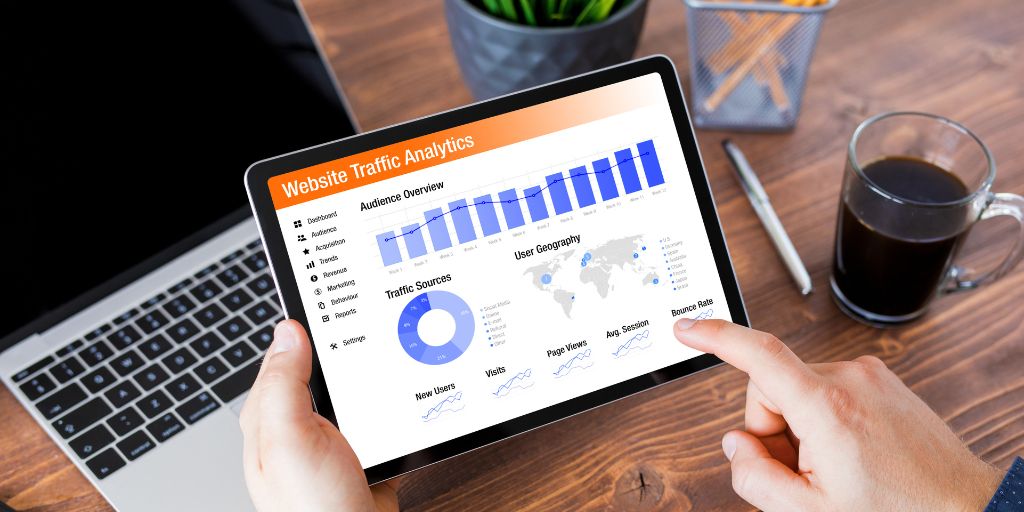
15 May What is GA4 And What Does It Mean For My Business
You’re getting emails about configuring GA4 and you’re seeing a big countdown timer when you log in to Google Analytics. So what’s going on? From 1 July 2023 Google Analytics as you know it right now will be gone. Google are sunsetting the current version (it’ll stop collecting data) and replacing it with Google Analytics 4, or GA4. This means that the existing Google Analytics you’re using for your website will need to be switched over to GA4, otherwise it won’t continue to track your website’s performance the way you want it to.
We know it might feel like you’ve just finally gotten into the groove with Google Analytics and now they’re changing it on you (we know that feeling!) To help, here’s some information about what GA4 is and what you need to do about it.
WHAT IS GA4?
GA4 is Google’s latest version of Google Analytics. Well, ‘latest version’ might not be the right term, as it’s actually a totally new way they track, collect, store, filter and display data for your website and app.
WHAT DOES GA4 DO DIFFERENTLY TO THE CURRENT VERSION OF GOOGLE ANALYTICS?
GA4 takes customer privacy into account and makes a big step towards a cookie-free online space. It’s moving away from third-party cookies and instead embraces machine learning to give more detailed insights into how visitors interact with your website. This machine learning can even develop predictive insights on possible user behaviour on your website.
- It can track the entire customer journey across multiple platforms, so not only can it track your website but if you have one it’ll track visitors on your app too.
- New streamed dashboard. But… the go to reports you always use in Google Analytics now will be history. So there’ll be a period of time needed where you set up the GA4 dashboard and reports to display the data you want, how you want it.
- Enhanced features and measurements and new reporting functions are geared to make this a more powerful iteration of Google Analytics.
- Enhanced measurement will see common user actions tracked without the usual website tags. Such as video views, site search, scrolling, downloads, and pageviews. This should make it easier to set up (once you work out how to set it up!).
- There’s new metrics and measurements, including ‘engagement’ and ‘events’. For example, ‘bounce rate’ is replaced with ‘engagement rate’. And instead of tracking sessions over a time period GA4 tracks all interactions as ‘events’ that are tied to the user. This is designed to track the customer, not just some clicks, prioritise people and not sessions, and provide a greater context into the user/event.
- Customer lifecycle insights with reports organised around the customer journey.
WHAT DOES IT MEAN FOR MY BUSINESS?
As it is a new way of collecting, filtering and displaying data, any historical data in the current Google Analytics you use won’t move over to GA4 (as they use totally different data models). If you haven’t already, we strongly advise that you get GA4 set up now so it’s already recording data before 1 July clicks over. If you already use Google Analytics you can add GA4 to your existing Google account.
With it all set up and collecting data, when Google sunset the Universal Google Analytics you can switch straight over to GA4.
Unlike Google Analytics, GA4 won’t show the usual reports with attributes you’re used to seeing. You’ll need to customise the reports yourself.
It might be confusing to use at the start. Take advantage of any online videos and sessions Google has to help develop your understanding of GA4 and how to get the data you want out of it (and how to find out about the data you didn’t know you wanted but can now get with GA4!).
You might be frustrated when trying to set up and work through it all. That’s normal! We find comfort in familiarity and when things change there’s always a period of learning and adapting.
Once you’re set up jump into your ‘old’ Google Analytics and export and save your historical reports and data. After the switch on 1 July 2023, you’ll only be able to access your old Google Analytics data for at least 6 months, so save this data before it’s gone (especially when you may have years and years of data).
If you don’t switch over to GA4, or have any analytics for that matter, you won’t know how your website and business is tracking. You won’t know how much website traffic your website is getting (if you’re getting any at all), where your website visitors are coming from, what information on your website they engage with, areas you need to work on, if your campaigns are working, where your conversions/goals are coming from, what improvements you need to make to your website, etc. Essentially GA4 should be a part of the suite of tools you use to manage and understand your website and your website visitors, and to measure your marketing activity.
MIGRATE TO GA4
Google have a guide for migrating from Google Analytics (Universal) to GA4.
Google also advise that if you haven’t already created a new GA4 property by now their Setup Assistant will create one for you, and it will include some conversion events, any existing Google Ads links and existing website tags.
START FROM SCATCH WITH GA4
Google also have a quickstart customised GA4 set up guide if you’ve never had a Google Analytics account for your website before.
RUNNING GOOGLE ADS?
You’ll be able to link your Google Ads account to your GA4 so you can see the full customer cycle.
NEED HELP?
If you’re not able to get this sorted out and need help, get in touch with our team. We can definitely do this all for you!
Our process:
-
-
-
- Access, review and audit
- Configuration and set up
- Tags and triggers
- Testing and monitoring
We can also help you with Google Ads and SEO, to drive traffic to your website and more.
-
-
